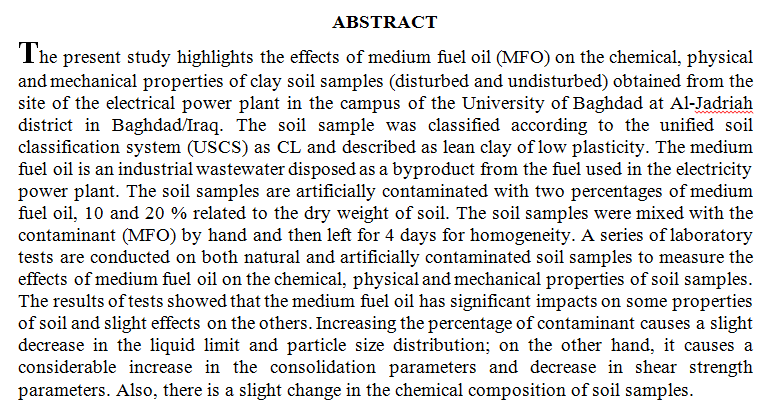
The high viscosity of heavy oil is a crucial factor that strongly affects its up-stream recovering, down-stream surface transporting and refining processes. Economical methods for recovering the heavy oil and reducing is very important and related to capital and/or operating cost. This research studies the treatment of Iraqi heavy crude oil, which characterize with high viscosity and low API which makes transportation of heavy crude oil a difficult mission, needs for treatment to reduce viscosity for facilitating transportation and processing. Iraqi heavy crude oil was used Sharqi Baghdad, which obtained from Baghdad east oil fields with API 22.2º.Many kinds of additives were used to reduce the viscosity, experiments were performed o
... Show More (4)
(4)
Two different oxidative desulfurization strategies based on oxidation/adsorption or oxidation/extraction were evaluated for the desulfurization of AL-Ahdab (AHD) sour crude oil (3.9wt% sulfur content). In the oxidation process, a homogenous oxidizing agent comprising of hydrogen peroxide and formic acid was used. Activated carbons were used as sorbent/catalyst in the oxidation/adsorption process while acetonitrile was used as an extraction solvent in the oxidation/extraction process. For the oxidation/adsorption scheme, the experimental results indicated that the oxidation desulfurization efficiency was enhanced on using activated carbon as catalyst/sorbent. The effects of the operating conditions (contact time, temperat
... Show MoreIn the present study, advanced oxidation process / heterogeneous photocatalytic process (UV/TiO2/Fenton) system was investigated to the treatment of oily wastewater. The present study was conducted to evaluate the effect of hydrogen peroxide concentration H2O2, initial amount of the iron catalyst Fe+2, pH, temperature, amount of TiO2 and the concentration of oil in the wastewater. The removal efficiency for the system UV/TiO2/Fenton at optimal conditions and dosage (H2O2 = 400mg/L, Fe+2 = 40mg/L, pH=5, temperature =30oC, TiO2=75mg/L) for 1000mg/L load was found to be 77%.
Aluminum foil cover around the re
... Show MoreThe implementation of nanotechnology in all industries is one of most significant research fields. Nanoparticles have shown a promising application in subsurface fields. On the other hand, various surfactants have been used in the oil industry to reduce oil/water interfacial tension and also widely used to stabilize the nano-suspensions. The primary objective of this study was to investigate the improvements of surfactants ability in term of interfacial tension (γ) reduction utilizing addition of silicon dioxide nanoparticles at different temperatures and salinity. The pendant drop technique has been used to measure γ and electrical conductivity has been used to measure the critical micelle concentration (CMC). The synergistic effects of
... Show More (44)
(44)
 (51)
(51)
A laboratory investigation of six different tests were conducted on silty clay soil spiked with lead in concentrations of 1500 mg/kg. A constant DC voltage gradient of 1 V/cm was applied for all these tests with duration of 7 days remediation process for each test. Different purging solutions and addition configurations, i.e. injection wells, were investigated experimentally to enhance the removal of lead from Iraqi soil during electro-kinetic remediation process. The experimental results showed that the overall removal efficiency of lead for tests conducted with distilled water, 0.1 M acetic acid, 0.2 M EDTA and 1 M ammonium citrate as the purging solutions were equal to 18 %, 37 %, 42 %, and 29 %, respectively. H
... Show More (23)
(23)
 (19)
(19)
 (1)
(1)
Uranium concentrations in soil were determined for ten locations in Salahdin governorate using CR-39 track detector, fission fragments track technique was used, the nuclear reaction of nuclear fission fragments obtained by the bombardment of 235U with thermal neutrons from (Am-Be) neutron source with flux (5000n.cm-2.s-1), the concentration values were calculated by a comparison with standard samples. The results of the measurements show that the uranium concentration in soil samples various from 0.42±0.018ppm in Beji province to 0.2±0.014 ppm in Tooz province with an average (0.31±0.08ppm), the values of uranium concentration in all samples are within the permissible limits universally.
 (6)
(6)
 (4)
(4)
Objectives: Maxillofacial silicone is used to restore abnormalities due to congenital or acquired causes. However, the quality of silicone is far from ideal. This study was aimed at assessing the influence of the addition of cellulose nanofibers (CNFs; several nanometers wide and 2-5 micro m long) on the physical and mechanical characteristics of maxillofacial silicone elastomers. Methods: Two CNF weight percentages (0.5% and 1%) were tested, and 180 specimens were divided into one control and two experimental groups. Each group was subdivided into six subgroups. In each subgroup, ten specimens subjected to each of the following tests: tearing strength, Shore-A hardness, tensile strength, elongation percentage, surface roughness, and color
... Show More (3)
(3)
 (2)
(2)
